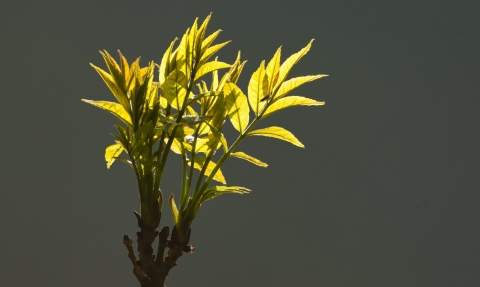
Ash leaves (Fraxinus excelsior) spring foliage. Photo by Mark Hamblin/2020VISION
Ash dieback
What is ash dieback and how serious is it?
Ash dieback is a fatal disease expected to kill up to 95% of the country’s ash trees (Fraxinus excelsior). Up to a third of England’s trees are ash, so the effects on the landscape and the many species that depend on ash will be devastating. The economic cost of the disease to the UK is predicted to reach anywhere up to £15 billion.
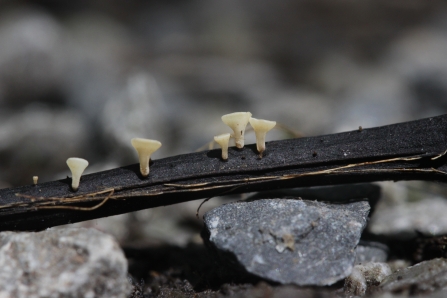
The fruiting bodies of ash dieback fungus, Hymenoscyphus fraxineus. Photo by Björn S.
What causes ash dieback?
Ash dieback is caused by a fungus (Hymenoscyphus fraxineus) that originates from eastern Asia but spread to Europe about 30 years ago. Its native hosts display good resistance to the disease but the European ash has no natural defence, which is why so many trees on the Continent and now in the UK have succumbed to the disease.
Our woodlands are suffering
When did ash dieback first appear here?
The disease was first detected in the UK in 2012. The fungus is likely to have arrived on imported saplings, although spores may have arrived here on the wind. Either way, the movement of potentially infected trees will almost certainly have helped to transmit the disease faster than it might otherwise have spread. Ash dieback now affects almost every part of the country, and our region is no exception.
What are the symptoms of ash dieback?
Any ash tree is susceptible to ash dieback, with younger trees succumbing more quickly than mature trees. Symptoms may include:
• Leaves: dark blotches on the leaves, which then wilt as they turn black in colour. Affected leaves are shed earlier than healthy leaves.
• Stems: lesions - typically diamond-shaped and dark brown - may develop where the branch meets the trunk. The wood underneath the bark discolours to a brownish-grey.
• Trees: widespread leaf and shoot dieback is obvious during the growing season. Trees often fight back by producing prolific growth lower down the trunk, known as epicormic growth.
How does ash dieback kill the trees?
Like most fungi, ash dieback produces fruiting bodies that release spores which are then carried on the wind. The light spores may be blown for many miles. Once they land on a suitable host the fungus sets to work, spreading throughout the leaf and out into the rest of the tree. In time the fungus blocks the tree’s nutrient and water transport systems, causing it to die back from the tips of the branches.
Infection can also enter the trunk, so a tree may appear healthy on the outside but be rotten on the inside. The disease can make trees very brittle, making it hard to predict when and in what direction branches and trees might fall. Infection also significantly weakens trees so they become susceptible to secondary infections, such as honey fungus.
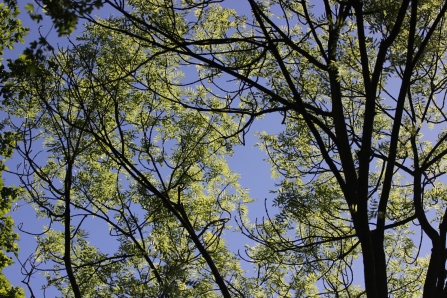
Ash tree, Fraxinus Excelsior. Photo by Björn S.
What is BBOWT doing about ash dieback?
Our ecologists are assessing the health of ash trees on our nature reserves. More than three-quarters of our nature reserves are affected and our response to the disease requires a significant investment in time and resources.
Affected trees close to footpaths or along roads compromise the public’s safety because of the very real risk of falling branches or collapsing trees. To ensure no one is hurt and no property is damaged we are undertaking a targeted programme of tree works on our nature reserves. Some trees need to be felled because they are already dead or dying. The loss of these trees will result in unavoidable changes to some of our nature reserves but the work is being timed to minimise the impact on wildlife such as nesting birds, with protections in place to safeguard the most sensitive wildlife.
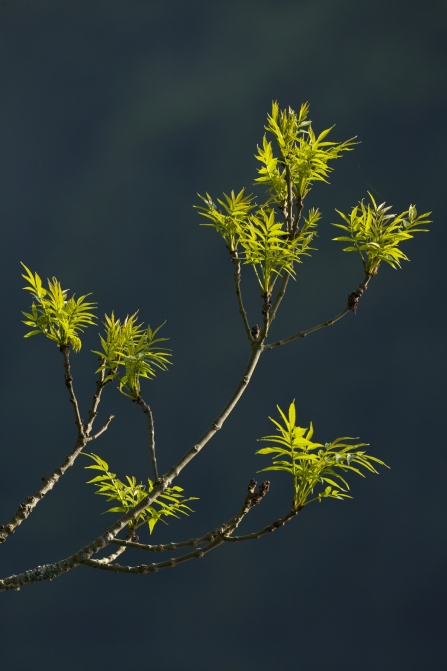
There is hope for ash in the UK. Photo by Mark Hamblin/2020VISION.
Is there any glimmer of hope?
Yes, there really is! Findings show that a small proportion of trees display tolerance to ash dieback, so where it is safe to do so we will allow nature to take its course in the hope that these trees will eventually help the ash population to recover.
But what about all those felled trees?
While it is distressing to see dead and dying trees, nature is dynamic and ash dieback will provide opportunities for other wildlife to thrive. The works will generate a lot of deadwood, most of it left in situ as habitat for hundreds of wildlife species. Up to 40% of woodland species depend on deadwood at some stage of their life, including many birds, mammals, fungi, plants and insects such as beetles.
Removing dead and dying trees will create glades and woodland rides, the most wildlife rich areas of any woodland habitat. The extra light is welcomed by breeding birds and invertebrates such as butterflies, including silver washed fritillaries and purple emperors. Wild flowers and shrubs will also thrive. In time wooded areas should recover through a combination of natural regeneration and replanting.
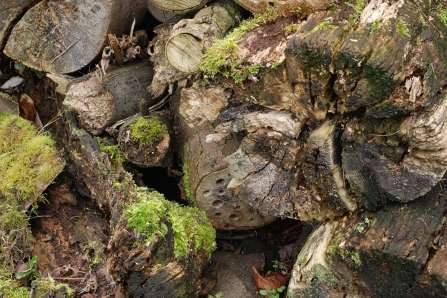
Deadwood is a vital habitat for lots of wildlife. Photo by Mike's Wildlife Garden.
And what about climate change?
Trees lock up carbon dioxide from the atmosphere, making them a powerful tool in the fight against climate change. While felling trees releases carbon when they rot down, many of the areas where ash is removed will return to woodland, which in turn will lock up more carbon. In the long term the carbon balance will remain the same.
Ash dieback FAQs
Which BBOWT nature reserves are affected?
All of BBOWT’s nature reserves where ash trees can be found will eventually be affected by ash dieback. Where tree safety works will result in path closures or diversions, we will include the information on our reserve webpages.
When will work begin?
Work to remove diseased ash trees from our nature reserves will begin in winter 2019 and continue for a number of years, until the disease has run its course. Work will be focussed on high risk areas to ensure the safety of the public and our staff.
Why do trees need to be felled?
Diseased ash trees can become extremely unstable and are at an increased risk of dropping limbs or complete collapse. The Trust has a duty of care, both morally and legally, to ensure that visitors, staff, volunteers and our neighbours are safe on or adjacent to land which the Trust is responsible for. As such it is inevitable that as trees become unsafe a significant number will need to be felled. This will be necessary on an annual basis until the disease has run its course.
Which trees will be cut down?
The health of trees on BBOWT nature reserves is assessed on an annual basis and a targeted programme of tree safety works carried out.
BBOWT will only fell trees in areas deemed ‘high risk’ such as adjacent to property boundaries, roadsides and around carparks and benches. BBOWT will consider rerouting paths away from high risk areas and closing permissive paths to reduce the amount of felling needed. Across the majority of reserves, where trees do not pose a risk to safety, ash will be left to die naturally.
The majority of trees will be identified for felling where they show greater than 50% canopy die-back and are at risk of collapse or shedding limbs. However, in some instances it may be necessary to fell trees with less than 50% canopy die-back, in high risk areas such as along road verges where the danger of tree collapse is particularly high, or on sites where access is particularly difficult.
The annual programme of assessment and felling will continue until the disease has run its course.
How will trees be removed?
BBOWT will employ skilled arboricultural contractors to carry out the felling works as in many cases this is too dangerous to be carried out by BBOWT staff. Initially chainsaws will be used to fell trees but as the disease progresses this may become increasingly difficult. This is because ash is known to become highly unstable as the disease develops, and trees become unsafe to climb or to fell. In these instances a cabbed vehicle will be used.
What about the wildlife that uses the trees?
BBOWT will ensure that any ash removal required for meeting health and safety responsibilities will also take into account the needs of protected species, such as bats and dormice, along with other woodland wildlife. This will include actions such as:
- Only felling in areas deemed ‘high risk’ - such as adjacent property boundaries, roadsides and around carparks and benches. Across the majority of reserves ash will be left to die naturally.
- The closure of permissive paths will be considered in order to increase areas where felling is not required.
- Phasing works over a number of years, rather than in a single operation, when safety requirements allow.
- ‘Soft-felling’ of trees with high bat roost value, where tree limbs are cut and left grounded over night to allow any bats to make their way out.
- Ensuring felling takes place in the winter so that it has limited negative impact on species.
In some woodlands the loss of ash may provide an opportunity to improve woodland structure, create open space, diversify tree species and increase dead wood, an important habitat for groups such as fungi and invertebrates. On some sites the loss of ash may also provide opportunities for habitat creation, such as the restoration of chalk grassland on areas which had naturally succeeded to ash woodland. There will also be an increase in scrub as other tree species begin to colonise the open spaces, benefitting species such as dormice and woodland birds.
Will you replant?
Trees and shrubs will be allowed to regenerate naturally where possible. A small percentage of ash trees will be resistant to the disease and healthy trees will be retained to allow the seed from these trees to naturally regenerate. The loss of ash from woods may allow other native tree species to benefit, colonising newly created open areas.
Where natural regeneration proves insufficient, BBOWT will restock with a diverse range of native, UK-grown trees.
Why can’t you leave dead trees standing?
We can in some areas. Where is it safe to do so we will leave dead trees standing to provide habitat for a huge range of species including bats, birds, invertebrates and fungi. In some cases we may re-route paths away from dead trees to ensure the safety of the public whilst enabling us to leave as many trees standing as possible.
What will happen to the wood?
The works will generate a lot of timber, much of it will be left in situ as habitat for species. Where is it safe to do so we will leave standing deadwood to benefit a wide range of species such as bats, birds, fungi and invertebrates.
Why are you felling trees when we should be planting trees to combat climate change?
It may initially appear that the loss of trees through ash dieback will have a negative climate impact by releasing carbon into the atmosphere; however this is not the case. Within any woodland trees naturally die, or are coppiced as part of vital woodland management for biodiversity, and as this wood slowly rots down in habitat piles, or as it is burnt, the carbon locked up within the wood is released into the atmosphere.
However, as the fallen or felled tree is replaced by a new tree, through natural regeneration or re-stocking, this released carbon is reabsorbed from the atmosphere. This is part of the natural carbon cycle and as long as the majority of ash dieback affected areas eventually return to woodland, the disease should not have any negative impact on atmospheric carbon loads.
What can we do to make sure our woods are more resilient in the future?
We will aim to retain as many potentially tolerant ash trees as possible, letting nature take its course by allowing diseased ash trees to decline. Newly created open areas will allow natural regeneration by seed from healthy ash trees, as well as other native species. If planting of new trees is required, we will use a mix of native tree species, increasing the species diversity of our woodlands. This helps to ensure that the woodland as a whole is more resistant to future environmental changes.



